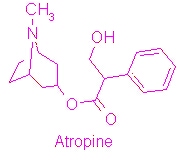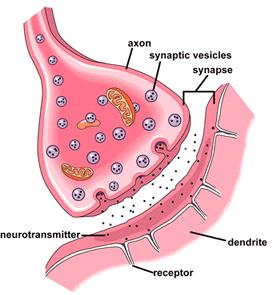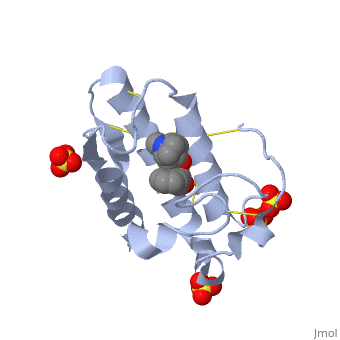Atropine
From Proteopedia
| Please do NOT make changes to this Sandbox until after May 10, 2011. Sandbox 53 is reserved until then for use by Lindsey Hayes - Messiah College, Grantham, PA (under the supervision of Dr. Hannah Tims). |
Contents |
Atropine
|
Introduction and Background
Atropine is an alkaloid drug derived from levohyscocyamine, a plant compound found in the family Solanaceae[2]. It's chemical name is 8-methyl-8-azabicycolo[3.2.1]oct-3-yl) 3-hydroxy-2-phenylpropanoate, and the most common medicinal form of atropine is atrophine sulfate ((C17H23NO3)2·H2SO4·H2O)[3]. It is a competitive inhibitor of both acetylcholine and phospholipase 2 and has a variety of effects on both humans and animals. In humans, it is metabolized approximately 50%, hydrolyzed to tropine and toropic acid, and the remaining unchanged drug is excreted in the urine[4].
As a plant compound, Atropine has been used for hundreds of years. Its first recorded use was in the 4th year of B.C.E, where it was used to treat wounds, gout, sleeplessnes, and was even thought to be a love potion[5]. It was also used by Cleopatra and women in the Renaissance era to dilate their pupils to give them a more beautiful appearance[6]. It has since been studied extensively and, although it is inherently poisonous, it is now used for a wide spectrum of medical ailments. It can be given orally, intravenously, rectally, or subcutaneously (in animals).
Function and Basic Mechanism
Atropine is part of the tropane group alkaloid family, which includes other substances such as cocaine. Atropine binds to acetylcholine receptors, blocking the action of acetylcholine and therefore suppressing the actions of the parasympathetic nervous system[7]. The protein structure of acetycholine receptor can be seen on the right. Although there is not a PDB ID for atropine in complex with the acetylcholine receptor, it is important to understand the structure of the acetylcholine receptor, and subsequently, how atropine and other alkaloids interact with it. One can see that each color in the current model represents a portion of the complex protien, which contains five domains. The regions can then be displayed in gray, while the hydrophillic regions appear purple. This shows a transmembrane alpha-helix region in the center of the molecule, a large hydrophillic complex on the exoplasmic face of the protein, and another hydrophillic region on the cystolic face of the protein.
The image above depicts a synapse. A neurotransmitter, such as acetylcholine, goes across the synaptic cleft and binds to its receptor. Atropine inhibits the effect of acetylcholine by complexing the acetylcholine receptor on the other side of the cleft, subsequently inhibiting the binding of acetylcholine to the receptor and inhibiting its effects.
Medical Uses
Since atropine affects the parasympathetic nervous system, it has a wide variety of effects. It is largely used as an ophthalmic drug, as it paralyzes the accommodation reflex and dilates the pupil[9]. It is most commonly seen in ophthalmics, as it paralyzes the accommodation reflex in the eye and dilates the pupils. The mechanism for dilation involves blocking the contraction of the circularly pupillary sphincter muscle, which is normally stimulated by acetylcholine release[10].
Outside of ophthalmic use, Atropine is also used in the treatment of heart conditions such as bradychardia (low heart rate), asystole, and subsequently, cardiac arrest. Because atropine blocks acetylcholine, and therefore the parasympathetic nervous system, the vagus nerve cannot slow the heart and it remains at a constant rate[11]. In addition, salivary, sweat, and mucus glands are inhibited by atropine, which is useful in treating asthma, or when keeping the airways of a surgical patient clear under anesthesia.
Atropine is also a good antidote for poisoning by organophosphates and nerve gases, prime agents in bioterrorism[12], because Atropine blocks acetylcholine at muscscarininc receptors. Atropine, however, has side effects that include nausea, dizziness, blurred visions, tachycardia, and hallucinations, and due to these side effects it has recently become more popular as a recreational drug.
Uses in Veterinary Medicine
Like human medicine, atropine is widely used in veterinary medicine in a variety of different medical situations. Although it is widely used in ophthalmic situations, it is even more commonly used as a preanesthetic in surgical patients to increase the heart rate and decrease mucous secretions, allowing the airway to remain clear during surgery. It is most often given subcutaneously, but can also be given as a pill. It is sometimes given in concjunction with morphine to decrease salivation that is often a side effect of morphine [13].
|
Interaction of Atropine with Phospholipase 2A
In addition to its ability to form complexes with acetylcholine receptors, atropine can also complex with phospholipase A2. Phospholipase A2 is a category of heat-stable enzymes which are involved in cell signaling processes, such as the inflammatory response [14].
Atropine can be seen in complex with phospholipase 2A on the right. The of phospholipase A in the active site can be seen when zooming in on the protein to the right.
References
- ↑ Image from: http://www.imctt-cw.org/pages/nerveagents.htm
- ↑ Atropine. Encyclopedia Brittanica. http://www.britannica.com/EBchecked/topic/42015/atropine
- ↑ Atropine. New World Encyclopedia. http://www.newworldencyclopedia.org/entry/Atropine
- ↑ Atropine. New World Encyclopedia. http://www.newworldencyclopedia.org/entry/Atropine
- ↑ Atropine. New World Encyclopedia. http://www.newworldencyclopedia.org/entry/Atropine
- ↑ Atropine. New World Encyclopedia. http://www.newworldencyclopedia.org/entry/Atropine
- ↑ Atropine. New World Encyclopedia. http://www.newworldencyclopedia.org/entry/Atropine
- ↑ Image from: http://www.neurevolution.net/category/history/page/2/
- ↑ Atropine. New World Encyclopedia. http://www.newworldencyclopedia.org/entry/Atropine
- ↑ Atropine. New World Encyclopedia. http://www.newworldencyclopedia.org/entry/Atropine
- ↑ Atropine. New World Encyclopedia. http://www.newworldencyclopedia.org/entry/Atropine
- ↑ Atropine. New World Encyclopedia. http://www.newworldencyclopedia.org/entry/Atropine
- ↑ Riviere, Jim E. Papich, Mark G. Veterinary Pharmacology and Therapeutics, 9th Edition. John Wiley and Sons, 2009.
- ↑ Kumar, Jainendra; Bala, Priti; Vihwal, Preeti. Analysis of Interaction of atropine with phospholipase A2 (1th6.pdb). Department of Botany and Biotechnlogy, College of Commerce, Patna, India.
Proteopedia Page Contributors and Editors (what is this?)
Lindsey Hayes, David Canner, Alexander Berchansky, Michal Harel, OCA



